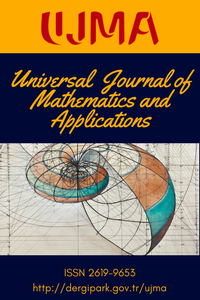Qualitative Analysis of a Nicholson-Bailey Model in Patchy Environment
Qualitative Analysis of a Nicholson-Bailey Model in Patchy Environment
We studied a host-parasite model qualitatively. The host-parasitoid model is obtained by modifying the Nicholson-Bailey model so that the number of hosts that parasitoids can't attack is fixed. Topological classification of equilibria is achieved with the implementation of linearization. Furthermore, Neimark-Sacker bifurcation is explored using the bifurcation theory of normal forms at interior steady-state. The bifurcation in the model is controlled by implementing two control strategies. The theoretical studies are backed up by numerical simulations, which show the conclusions and their importance.
Keywords:
Bifurcation, Chaos control Nicholson-Bailey model, Stability,
___
- [1] V. A. Bailey, A. J. Nicholson, The balance of animal populations, I Proc. Zool. Soc. Lond., 3 (1935), 551-598.
- [2] M. P. Hassell, The Dynamics of Arthropod Predator-Prey Systems, Princeton (NJ) Princeton University Press, 1978.
- [3] R. Wongsathan, Numerical simulation of coexist between host and parasitoid for improved modification of Nicholson-Bailey model, IEEE, (2009), 1002-1006.
- [4] V. L. Kocic, G. Ladas, Global Behavior of Nonlinear Difference Equations of Higher Order with Applications, Kluwer Academic Publishers, London, 1993.
- [5] H. Sedaghat, Nonlinear Difference Equations: Theory with Applications to Social Science Models, Kluwer Academic, Dordrecht, 2003.
- [6] L. Edelstein-Keshet, Mathematical models in Biology, McGraw-Hill, British Columbia, 1988.
- [7] S. N. Elaydi, (2nd edn) Discrete chaos with applications in science and engineering, Champan and Hall/CRC, Texas, 2008.
- [8] R. Ahmed, M. S. Yazdani, Complex dynamics of a discrete-time model with prey refuge and Holling type-II functional response, J. Math. Comput. Sci., 12 (2022), Article ID 113.
- [9] S. Akhtar, R. Ahmed, M. Batool, N. A. Shah, J. D. Chung, Stability, bifurcation and chaos control of a discretized Leslie prey-predator model, Chaos, Solitons & Fractals, 152 (2021), 111345.
- [10] A. Q. Khan, E. Abdullah, T. F. ˙Ibrahim, Supercritical Neimark-Sacker bifurcation and hybrid control in a discrete-time glycolytic oscillator model, Mathematical Problems in Engineering, 2020(3) (2020), 1-15.
- [11] M. R. S. Kulenovic, D. T. McArdle, Global dynamics of Leslie-Gower competitive systems in the plane, Mathematics, 7(1) (2019), 76.
- [12] P. A. Naik, Z. Eskandari, H. E. Shahraki, Flip and generalized flip bifurcations of a two-dimensional discrete-time chemical model, Mathematical Modelling and Numerical Simulation with Applications, 1(2) (2021), 95-101.
- [13] P. A. Naik, Z. Eskandari, M. Yavuz, J. Zu, Complex dynamics of a discrete-time Bazykin-Berezovskaya prey-predator model with a strong Allee effect. Journal of Computational and Applied Mathematics, 413 (2022), 114401.
- [14] M. N. Qureshi, A. Q. Khan, Q. Din, Asymptotic behavior of a Nicholson-Bailey model, Adv. Differ. Equ., 2014 (2014), Article number: 62.
- [15] U¨ . Ufuktepe, S. Kapc¸ak, Stability analysis of a host parasite model, Adv. Differ. Equ., 2013 (2013), Article number: 79.
- [16] Q. Din, Global behavior of a host-parasitoid model under the constant refuge effect, Appl. Math. Model., 40 (2016), 2815-2826.
- [17] X. Liu, D. Xiao, Complex dynamic behaviors of a discrete-time predator-prey system, Chaos, Solitons & Fractals, 32 (2007), 80-94.
- [18] Q. Din, Global stability and Neimark-Sacker bifurcation of a host-parasitoid model, Int. J. Syst. Sci., 48 (2017), 1194-1202.
- [19] Z. He, X. Lai, Bifurcation and chaotic behavior of a discrete-time predator-prey system, Nonlinear Anal. RWA, 12 (2011), 403-417.
- [20] B. Li, Z. He, Bifurcations and chaos in a two-dimensional discrete Hindmarsh-Rose model, Nonlinear Dyn, 76 (2014), 697-715.
- [21] Z. Jing, J. Yang, Bifurcation and chaos in discrete-time predator-prey system, Chaos, Solitons & Fractals, 27 (2006), 259-277.
- [22] L. G. Yuan, Q. G. Yang, Bifurcation, invariant curve and hybrid control in a discrete-time predator-prey system, Appl. Math. Model., 39 (2015), 2345-2362.
- [23] H. N. Agiza, E. M. ELabbasy, H. El-Metwally, A. A. Elsadany, Chaotic dynamics of a discrete prey-predator model with Holling type II, Nonlinear Anal. RWA, 10 (2009), 116-129.
- [24] Y. A. Kuznetsov, Elements of Applied Bifurcation Theory, Springer-Verlag, New York, 1997.
- [25] A. L. Fradkov, R. J. Evans, Control of chaos: Methods and applications in engineering, Annu. Rev. Control., 29 (2005), 33-56.
- [26] S. Lynch, Dynamical Systems with Applications Using Mathematica, Birkh¨auser, Boston, 2007.
- [27] G. Chen, X. Dong, From Chaos to Order: Perspectives, Methodologies, and Applications, World Scientific, Singapore, 1998.
- [28] Q. Din, O. A. G¨um¨us¸, H. Khalil, Neimark-sacker bifurcation and chaotic behaviour of a modified host–parasitoid model, Zeitschrift f¨ur Naturforschung A, 72(1) (2017), 25-37.
- [29] O. A. G¨um¨us¸, M. Feckan, Stability, Neimark-Sacker bifurcation and chaos control for a prey-predator system with harvesting effect on predator, Miskolc Mathematical Notes, 22(2) (2021), 663-679.
- [30] L. Fei, X. Chen, B. Han, Bifurcation analysis and hybrid control of a discrete-time predator–prey model, Journal of Difference Equations and Applications, 27(1) (2021), 102-117.
- [31] O. A. G¨um¨us¸, A. G. M. Selvam, R. Janagaraj, Neimark-Sacker bifurcation and control of chaotic behavior in a discrete-time plant-herbivore system, Journal of Science and Arts, 22(3) (2022), 549-562.
- [32] A. Q. Khan, T. Khalique, Neimark-Sacker bifurcation and hybrid control in a discrete-time Lotka-Volterra model, Mathematical Methods in the Applied Sciences, 43(9) (2020), 5887-5904.
- [33] Q. Zhou, F. Chen, S. Lin, Complex Dynamics Analysis of a Discrete Amensalism System with a Cover for the First Species, Axioms, 11(8)(2022), 365.
- ISSN: 2619-9653
- Başlangıç: 2018
- Yayıncı: Emrah Evren KARA
Sayıdaki Diğer Makaleler
Theorems of Second Korovkin Type with respect to Triangular $A$-Statistical Convergence
A New Analytic Solution Method for a Class of Generalized Riccati Differential Equations
The Geometry of Bezier Curves in Minkowski 3−Space
Qualitative Analysis of a Nicholson-Bailey Model in Patchy Environment
